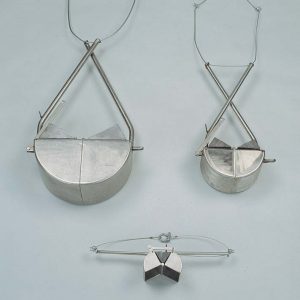

Sediment Sampling

March 30, 2016
 Sampling weak sediments presents particular challenges. Sampling devices can be easily inserted but retention is mostly a problem and so sampling tools need to include a valve of sorts to capture the material. This can be a flap, a piston (with or without check valve) or a closing mechanism at the foot of the sampler.
Sampling weak sediments presents particular challenges. Sampling devices can be easily inserted but retention is mostly a problem and so sampling tools need to include a valve of sorts to capture the material. This can be a flap, a piston (with or without check valve) or a closing mechanism at the foot of the sampler.
Similar to soil samplers there are a number of options and the choice of one tool over another will be determined by the application.
- Bed Grab Samplers: If the sample is below a depth of water, for example rivers, lakes, ponds, a “jaw” type sampler is easy to deploy even in deep water. The Van Veen Grabs are good examples and they come in a variety from sizes. They will just capture the surface few centimetres.
- Piston Type Samplers: When undisturbed samples are necessary then piston type samplers are very useful. There are many types and generally they are capable of taking samples in a liner of 100 cm:
Stitz-Corer: A metal piston sampler which is inserted in a closed position and mechanically driven to the required depth when it is remotely opened by cable. The Stitz is suitable for most types of weak sediment; fast, reliable and good sample retention to depths of up to 10 metres.
Multi-Sampler: Hand held piston type sampler which captures the sediment in a clear plastic liner. If the sediment is very weak then a check valve can be added for better sample retention. The Multi-Sampler can also be used below the water. Typical depths, 4-7 metres. This is a very lightweight and easy to use sampler,
Beeker-Sampler: Very similar to the Multi-Sampler but rather more sophisticated in that the head contains an inflatable bladder which seals off the head ensuring full retention of the sample. Because samples are so well retained and almost perfectly undisturbed the Beeker-Sampler is ideal for research which requires very precise profiling. It can be used below the water up to depths of 7 metres. The Beeker Sampler is often the tool of choice when the water/sediment interface is important as both can be represented as a profile in the sampler. A likely application would be the investigation of pollutants in the top layers of a river, lake or sea bed.
- Flap Gouges: The best known is the so-called “Russian Corer” and it is very fast to sample peat or other weak sediments. Inserted in a closed position it is “speared” into the ground to the required depth. The sample is captured within the integrated chamber and retained by the “flap”.
- Gouge Augers: Resembling an over-sized cheese-corer and whereas these augers are also used for heavier soils (in fact a window sampler is a type of gouge auger), they are particularly useful for semi weak sediments as they are available in different diameters and have operational lengths of 100cm. They are very effective at quickly taking undisturbed profile samples. Generally they are more useful for peat substrates but will also work well in more cohesive sediments.
You might also be interested in...
Van Walt Guidelines for sampling for PFAS in Groundwater
November 13, 2024We need to make clear, that at the time of writing, there are no ISO or EN standards which deal with the sampling of groundwater for PFAS.
Read MoreSpot measurement v. continuous environmental monitoring
August 25, 2023Environmental monitoring has developed considerably over the years. From the time when a consultant went out monthly or quarterly with a dip tape to monitor the groundwater level in a borehole, wind forward...
Read MoreMeasuring Nitrates (NO3, NO3-N) in the field
June 20, 2023The interest in Nitrates is nothing new. One way or another we have been measuring them for half a century.
Read MoreVan Walt Environmental Equipment
A small selection of our environmental equipment